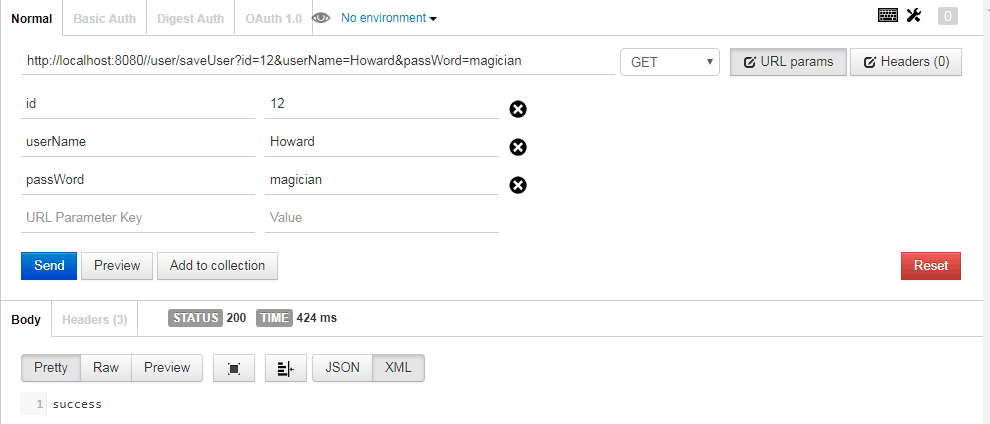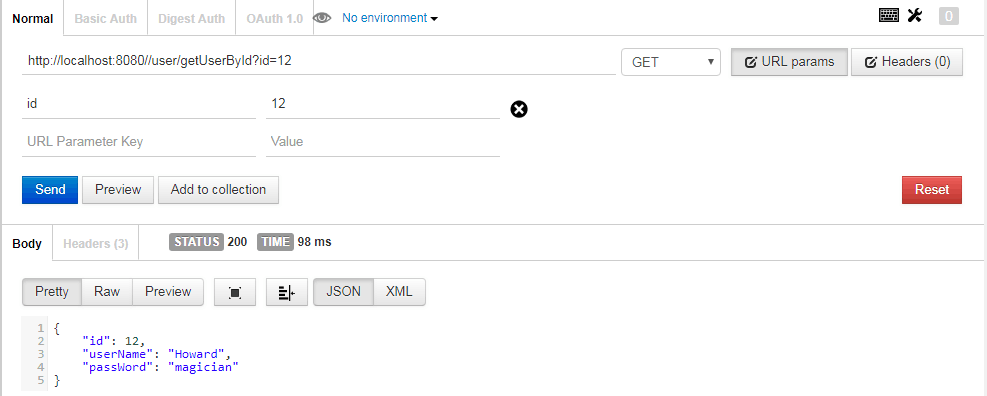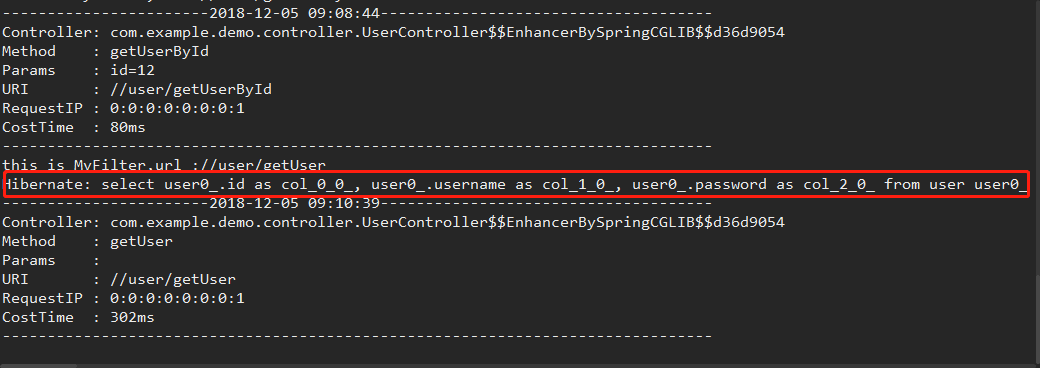Spring Boot 2.x整合Redis
最近在学习Spring Boot 2.x整合Redis,在这里和大家分享一下,希望对大家有帮助。
Redis是什么
Redis 是开源免费高性能的key-value数据库。有以下的优势(源于Redis官网http://www.redis.net.cn/):
性能极高 – Redis能读的速度是110000次/s,写的速度是81000次/s 。
丰富的数据类型 – Redis支持二进制案例的 Strings, Lists, Hashes, Sets 及 Ordered Sets 数据类型操作。
原子 – Redis的所有操作都是原子性的,意思就是要么成功执行要么失败完全不执行。单个操作是原子性的。多个操作也支持事务,即原子性,通过MULTI和EXEC指令包起来。
丰富的特性 – Redis还支持 publish/subscribe, 通知, key 过期等等特性。
如果想了解更多关于Redis是什么,可以参考:Redis初识
为什么要使用Redis
为什么要使用Redis?21世纪以来信息技术的飞速发展,我们已经迎来了大数据时代,数据较之前爆炸增长,并发访问量激增;由之带来的就是系统设计由单体架构向分布式架构的转变和演进。对于缓存这个问题,如果系统是单体的系统,可以在单个的JVM里面进行本地缓存,例如可以用HashMap来缓存一些数据。但是到了分布式系统里面,一个大系统里面有很多个子系统,那他们之间如何共享缓存?这就需要Redis,用Redis来实现缓存系统。都说“时势造英雄”,其实我想说Redis的大规模使用也是这个道理,用Redis做缓存系统从性能和并发两方面考虑都是值得肯定的。
- 性能:如果碰到需要执行耗时特别久,且结果不频繁变动的SQL,就特别适合将运行结果放入缓存。这样,后面的请求就去缓存中读取,使得请求能够迅速响应。
- 并发: 在大并发的情况下,所有的请求直接访问数据库,数据库会出现连接异常。这个时候,就需要使用redis做一个缓冲操作,让请求先访问到Redis,而不是直接访问数据库。
更多关于“为什么要使用Redis”,博客园【原创】分布式之redis复习精讲 ,这篇博文关于Redis的讲解我觉得超赞,谢谢作者的耐心分享。
Spring Boot 2.x如何整合Redis
我使用的Spring Boot版本是2.1.0,根据网上的一些旧的教程进行整合Redis 3.2的时候,会有许多地方有错误提示。这是因为Spring Boot 2.x做了一些修改,这些修改对使用而有没有影响呢?我们改怎么整合呢?下面就进入正式的整合过程。
1. pom.xnl引入依赖
<dependency>
<groupId>org.springframework.boot</groupId>
<artifactId>spring-boot-starter-redis</artifactId>
</dependency>
现在会提示Project build error: 'dependencies.dependency.version' for org.springframework.boot:spring-boot-starter-redis:jar is missing. 提示spring-boot-starter-redis:jar找不到。
这是因为Spring Boot 1.4之后不再支持spring-boot-starter-redis,更换spring-boot-starter-data-redis之后就可以了。如果你的pom文件报错,请检查是否将spring-boot-starter-redis 改成了spring-boot-starter-data-redis。
Spring Boot 2.x要使用下面的依赖:
<dependency>
<groupId>org.springframework.boot</groupId>
<artifactId>spring-boot-starter-data-redis</artifactId>
</dependency>
2. application.properties添加配置文件
这是之前版本的配置文件:
# REDIS (RedisProperties)
# Redis数据库索引(默认为0)
spring.redis.database=0
# Redis服务器地址
spring.redis.host=127.0.0.1
# Redis服务器连接端口
spring.redis.port=6379
# Redis服务器连接密码(默认为空)
spring.redis.password=
# 连接池最大连接数(使用负值表示没有限制)
spring.redis.pool.max-active=8
# 连接池最大阻塞等待时间(使用负值表示没有限制)
spring.redis.pool.max-wait=-1
# 连接池中的最大空闲连接
spring.redis.pool.max-idle=8
# 连接池中的最小空闲连接
spring.redis.pool.min-idle=0
# 连接超时时间(毫秒)
spring.redis.timeout=0
如果Spring Boot 2.x这么配置,有错误提示 Property 'spring.redis.pool.max-active' is Deprecated: Use 'spring.redis.jedis.pool.max-idle' instead. 'spring.redis.pool.max-active'已经被弃用了,推荐使用'spring.redis.jedis.pool.max-idle'来代替。
这是因为在2.x中配置redis的连接池信息时,不再使用spring.redis.pool的属性,而是直接使用redis的lettuce或jedis客户端来配置。现在的配置如下:
# REDIS (RedisProperties)
# Redis数据库索引(默认为0)
spring.redis.database=0
# Redis服务器地址
spring.redis.host=127.0.0.1
# Redis服务器连接端口
spring.redis.port=6379
# Redis服务器连接密码(默认为空)
spring.redis.password=
# 连接池最大连接数(使用负值表示没有限制)
spring.redis.jedis.pool.max-active=8
# 连接池最大阻塞等待时间(使用负值表示没有限制)
spring.redis.jedis.pool.max-wait=-1
# 连接池中的最大空闲连接
spring.redis.jedis.pool.max-idle=8
# 连接池中的最小空闲连接
spring.redis.jedis.pool.min-idle=0
# 连接超时时间(毫秒)
spring.redis.timeout=0
3. 配置CacheManager
这是之前的RedisConfig配置类:
@Configuration
@EnableCaching
public class RedisConfig extends CachingConfigurerSupport {
@Bean
public CacheManager cacheManager(RedisTemplate<?, ?> redisTemplate) {
CacheManager cacheManager = new RedisCacheManager(redisTemplate);
return cacheManager;
} @Bean
public RedisTemplate<String, String> redisTemplate(RedisConnectionFactory factory) {
RedisTemplate<String, String> redisTemplate = new RedisTemplate<String, String>();
redisTemplate.setConnectionFactory(factory);
return redisTemplate;
}
}
现在这么写会有报错The constructor RedisCacheManager(RedisTemplate<capture#1-of ?,capture#2-of ?>) is undefined。
这是因为Spring Boot 2.x版本删除了RedisCacheManager这个构造器, 也不可以通过之前的setDefaultExpiration方法设置默认的缓存过期时间等。
那么要怎样构造一个 RedisCacheManager?看看官方文档中怎么说?文档地址:https://docs.spring.io/spring-data/data-redis/docs/2.1.x/reference/html/#new-in-2.1.0
官方文档5.13.1. Support for the Spring Cache Abstraction(对Spring Cache Abstraction的支持)是关于怎么配置缓存的说明,我尝试着翻译了一下(蓝色部分),英文水平有限,各位轻喷。
Spring Redis provides an implementation for the Spring cache abstraction through the org.springframework.data.redis.cache package. To use Redis as a backing implementation, add RedisCacheManager to your configuration, as follows:
Spring Redis在 org.springframework.data.redis.cache 包中为Spring缓存抽象提供了一个实现方案。要使用Redis作为支持实现,需要将RedisCacheManager添加到配置中,如下所示:
@Bean
public RedisCacheManager cacheManager(RedisConnectionFactory connectionFactory) {
return RedisCacheManager.create(connectionFactory);
}
RedisCacheManager behavior can be configured with RedisCacheManagerBuilder, letting you set the default RedisCacheConfiguration, transaction behavior, and predefined caches.
RedisCacheManager可以用 RedisCacheManagerBuilder 进行配置,允许自定义设置默认的RedisCacheConfiguration、事务行为和预定义的缓存。
RedisCacheManager cm = RedisCacheManager.builder(connectionFactory)
.cacheDefaults(defaultCacheConfig())
.initialCacheConfigurations(singletonMap("predefined", defaultCacheConfig().disableCachingNullValues()))
.transactionAware()
.build();
As shown in the preceding example, RedisCacheManager allows definition of configurations on a per-cache basis.
正如上面的例子所示,RedisCacheManager 允许基于每个缓存进行配置。
The behavior of RedisCache created with RedisCacheManager is defined with RedisCacheConfiguration. The configuration lets you set key expiration times, prefixes, and RedisSerializer implementations for converting to and from the binary storage format, as shown in the following example:
RedisCacheManager创建RedisCache的行为被定义为RedisCacheConfiguration。该配置允许设置键值过期时间、前缀和RedisSerializer实现等属性,以便与二进制存储格式进行转换,如下所示:
RedisCacheConfiguration config = RedisCacheConfiguration.defaultCacheConfig()
.entryTtl(Duration.ofSeconds(1))
.disableCachingNullValues();
RedisCacheManager defaults to a lock-free RedisCacheWriter for reading and writing binary values. Lock-free caching improves throughput. The lack of entry locking can lead to overlapping, non-atomic commands for the putIfAbsent and clean methods, as those require multiple commands to be sent to Redis. The locking counterpart prevents command overlap by setting an explicit lock key and checking against presence of this key, which leads to additional requests and potential command wait times.
It is possible to opt in to the locking behavior as follows:
也可以选择锁定行为,如下所示:
RedisCacheManager cm = RedisCacheManager.build(RedisCacheWriter.lockingRedisCacheWriter())
.cacheDefaults(defaultCacheConfig())
...
By default, any key for a cache entry gets prefixed with the actual cache name followed by two colons. This behavior can be changed to a static as well as a computed prefix.
The following example shows how to set a static prefix:
以下示例显示如何设置静态前缀:
// static key prefix
RedisCacheConfiguration.defaultCacheConfig().prefixKeysWith("( ͡° ᴥ ͡°)"); The following example shows how to set a computed prefix: // computed key prefix
RedisCacheConfiguration.defaultCacheConfig().computePrefixWith(cacheName -> "¯\_(ツ)_/¯" + cacheName);
The following table lists the default settings for RedisCacheManager:
下表列出了RedisCacheManager的默认设置:
|
Setting
|
Value
|
|
Cache Writer
|
Non-locking
|
|
Cache Configuration
|
RedisCacheConfiguration#defaultConfiguration
|
|
Initial Caches
|
None
|
|
Trasaction Aware
|
No
|
The following table lists the default settings for RedisCacheConfiguration:
下表列出了RedisCacheConfiguration的默认设置:
|
Key Expiration
|
None
|
|
Cache null
|
Yes
|
|
Prefix Keys
|
Yes
|
|
Default Prefix
|
The actual cache name
|
|
Key Serializer
|
StringRedisSerializer
|
|
Value Serializer
|
JdkSerializationRedisSerializer
|
|
Conversion Service
|
DefaultFormattingConversionService with default cache key converters
|
对于Spring Boot 2.x,这里我使用RedisCacheConfiguration简单配置一下缓存时间,完成RedisCacheManager的配置,代码如下:
@Configuration
@EnableCaching
public class RedisConfig extends CachingConfigurerSupport { @Bean
public CacheManager cacheManager(RedisConnectionFactory factory) {
RedisCacheConfiguration config = RedisCacheConfiguration.defaultCacheConfig().entryTtl(Duration.ofSeconds(1));
RedisCacheManager cacheManager = RedisCacheManager.builder(factory).cacheDefaults(config).build();
return cacheManager;
}
}
4. Service层
在这里仅创建一个简单的RedisService,来进行存取缓存数据。
@Service
public class RedisService {
@Resource
private RedisTemplate<String, Object> redisTemplate;
public void set(String key, Object value) {
//更改在redis里面查看key编码问题
RedisSerializer redisSerializer = new StringRedisSerializer();
redisTemplate.setKeySerializer(redisSerializer);
ValueOperations<String, Object> vo = redisTemplate.opsForValue();
vo.set(key, value);
} public Object get(String key) {
ValueOperations<String, Object> vo = redisTemplate.opsForValue();
return vo.get(key);
}
}
5. Model层
实体类没有修改,和之前文章里面用的一样:
@Entity
@Table(name = "user")
public class User implements Serializable { private static final long serialVersionUID = 1L; @Id
@GeneratedValue
private Long id;
@Column(name = "username")
private String userName;
@Column(name = "password")
private String passWord; public User() {
super();
} public User(String userName, String passWord) {
super();
this.userName = userName;
this.passWord = passWord;
} public User(Long id, String userName, String passWord) {
super();
this.id = id;
this.userName = userName;
this.passWord = passWord;
} public Long getId() {
return id;
} public void setId(Long id) {
this.id = id;
} public String getUserName() {
return userName;
} public void setUserName(String userName) {
this.userName = userName;
} public String getPassWord() {
return passWord;
} public void setPassWord(String passWord) {
this.passWord = passWord;
} }
6. Controller层
@RestController
@RequestMapping("user")
public class UserController {
@Autowired
private UserRepository userRepository; @Autowired
private RedisService redisService; @RequestMapping("/saveUser")
public String saveUser(Long id, String userName, String passWord) {
User user = new User(id, userName, passWord);
redisService.set(id + "", user);
return "success";
} @RequestMapping("/getUserById")
public User getUserById(Long id) {
User res = (User) redisService.get(id + "");
return res;
}
}
7. 测试
使用Postman进行测试,访问http://localhost:8080//user/saveUser?id=12&userName=Howard&passWord=magician,添加了一个User。

看看Redis数据库,使用get key查看,得到一个对象:

http://localhost:8080//user/getUserById?id=12,通过id获取User。

这是过滤器和拦截器的日志信息,可以看到没有进行MySQL数据库的操作,直接从缓存中读取,说明Redis配置生效了:

如果访问之前的接口,是有操作数据库的:

总结
Spring Boot 2.x整合Redis的更多相关文章
- Spring Boot 2.x 整合 Redis最佳实践
一.前言 在前面的几篇文章中简单的总结了一下Redis相关的知识.本章主要讲解一下 Spring Boot 2.0 整合 Redis.Jedis 和 Lettuce 是 Java 操作 Redis 的 ...
- Spring Boot WebFlux-06——WebFlux 整合 Redis
第06课:WebFlux 整合 Redis 前言 上一篇内容讲了如何整合 MongoDB,这里继续讲如何操作 Redis 这个数据源,那什么是 Reids? Redis 是一个高性能的 key-val ...
- Spring Boot 学习笔记--整合Redis
1.新建Spring Boot项目 添加spring-boot-starter-data-redis依赖 <dependency> <groupId>org.springfra ...
- Spring Boot不同版本整合Redis的配置
1. Spring Boot为1.4及其他低版本 1.1 POM.XML配置 <!--引入 spring-boot-starter-redis(1.4版本前)--> <depende ...
- Spring Boot 2.X整合Spring-cache,让你的网站速度飞起来
计算机领域有人说过一句名言:“计算机科学领域的任何问题都可以通过增加一个中间层来解决”,今天我们就用Spring-cache给网站添加一层缓存,让你的网站速度飞起来. 本文目录 一.Spring Ca ...
- Spring boot配置多个Redis数据源操作实例
原文:https://www.jianshu.com/p/c79b65b253fa Spring boot配置多个Redis数据源操作实例 在SpringBoot是项目中整合了两个Redis的操作实例 ...
- Spring Boot 2.0 整合携程Apollo配置中心
原文:https://www.jianshu.com/p/23d695af7e80 Apollo(阿波罗)是携程框架部门研发的分布式配置中心,能够集中化管理应用不同环境.不同集群的配置,配置修改后能够 ...
- spring boot 2.0 整合 elasticsearch6.5.3,spring boot 2.0 整合 elasticsearch NoNodeAvailableException
原文地址:spring boot 2.0 整合 elasticsearch NoNodeAvailableException 原文说的有点问题,下面贴出我的配置: 原码云项目地址:https://gi ...
- Spring Boot入门 and Spring Boot与ActiveMQ整合
1.Spring Boot入门 1.1什么是Spring Boot Spring 诞生时是 Java 企业版(Java Enterprise Edition,JEE,也称 J2EE)的轻量级代替品.无 ...
随机推荐
- Centos6离线安装MySQL5.5.55-1(附带安装包及Perl依赖包)
资源包下载https://pan.baidu.com/s/1U3myYp4GSmDUfZocMWI9FA 密码:xdac 资源包所带有的资源截图 1.上传MySQL-client-5.5.55-1.l ...
- 百度搜索(jsonp)
<!DOCTYPE html><html> <head> <meta charset="UTF-8"> <title>百 ...
- PAT1110:Complete Binary Tree
1110. Complete Binary Tree (25) 时间限制 400 ms 内存限制 65536 kB 代码长度限制 16000 B 判题程序 Standard 作者 CHEN, Yue ...
- SSM-SpringMVC-22:SpringMVC中转发(forward)和重定向(redirect)
------------吾亦无他,唯手熟尔,谦卑若愚,好学若饥------------- 转发和重定向大家都熟悉,都学到框架了,怎么能不了解转发和重定向呢? 如果有不熟悉的,可以去百度搜几篇博客去看看 ...
- 我珍藏的神兵利器 - 效率工具for Win[转]
工欲善其事必先利其器. 我一直都在不断挑选和优化自己的兵器,以追求着最高效率. 此篇分享下我的私家珍藏的各种神兵利器.如果有朋友能推荐更好的,那就不枉此篇. 分为Windows软件和开发工具两 ...
- ORALCE删除临时表空间的方法---解决ORA01033: oralce initialization or shutdown in progress方案
当一台主机上oralce 临时表空间太多,而又用不到这些临时表空间的时候, TABLESPACE 会占用大量的存储空间.本文介绍一种删除ORACLE 临时表空间的方法. 一 启动任务管理器.在任 ...
- 工作流引擎Activiti 专题
https://github.com/Activiti/Activiti Quick Start Guide This quick start assumes: Familiarity with Ma ...
- Java 实现 HttpClients+jsoup,Jsoup,htmlunit,Headless Chrome 爬虫抓取数据
最近整理一下手头上搞过的一些爬虫,有HttpClients+jsoup,Jsoup,htmlunit,HeadlessChrome 一,HttpClients+jsoup,这是第一代比较low,很快就 ...
- 你不知道的JavaScript--Item5 全局变量
1.尽量少用全局对象 全局变量的问题在于,你的JavaScript应用程序和web页面上的所有代码都共享了这些全局变量,他们住在同一个全局命名空间,所以当程序的两个不同部分定义同名但不同作用的全局变量 ...
- [转]树莓派.设置自动重连WiFi
由于不可知的原因,有可能会导致树莓派失去连接,这时候需要重新连接WiFi. 自动重连的原理是,定期查看是否断网,如果断网了重启WiFi,参考的文章是这篇,第一步略有修改. 1.Python 代码 au ...
